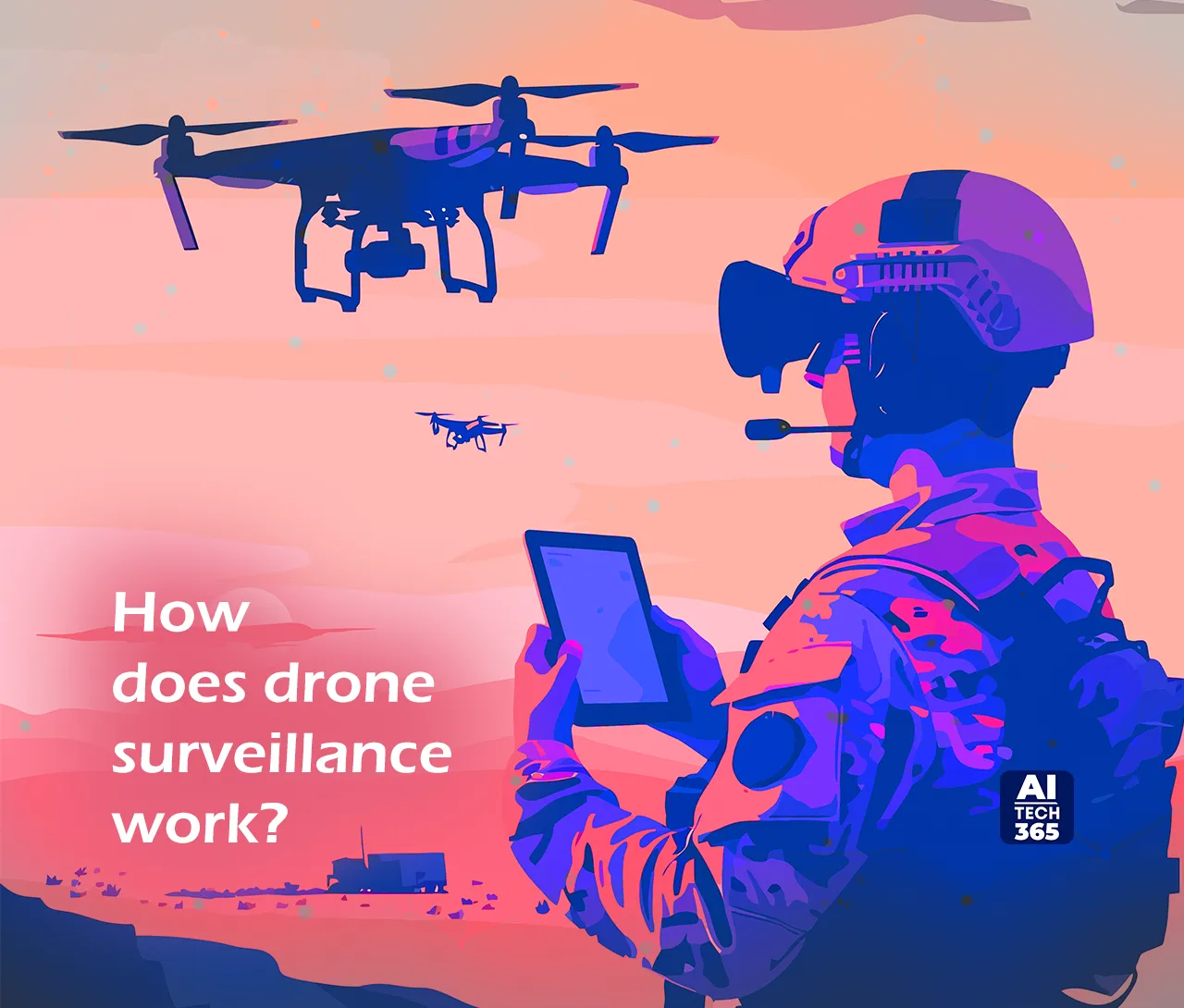Drone surveillance has rapidly evolved, becoming crucial in various sectors, from security to search and rescue. By leveraging unmanned aerial vehicles (UAVs) equipped with advanced cameras and sensors, drone surveillance offers a unique and powerful perspective for monitoring and data collection. In this post, we’ll explore how surveillance works, its integration with AI for enhanced capabilities, the legal landscape, and more.
What does drone surveillance mean?
Unmanned aerial vehicles, also referred to as drones, are used in drone surveillance to monitor and collect data about particular targets or locations from the air.
With the use of this technology, still photos and videos can be taken from a distance or at a high altitude, offering a distinctive long-range surveillance viewpoint that is frequently impossible to obtain with conventional surveillance techniques.
How does drone surveillance work?
Drone surveillance operates through a combination of advanced technology, involving unmanned aerial vehicles, sensors, and software systems. Surveillance drones are equipped with various types of cameras and sensors, such as high-definition video cameras, infrared cameras, and thermal sensors.
These allow them to capture detailed images and videos even in low-light conditions or at significant distances.
Typically controlled remotely by operators using ground control stations, these systems enable
- navigation
- altitude adjustments
- and camera direction
Some autonomous drones can also operate independently, following pre-programmed flight paths or responding to real-time commands.
The data is transmitted back to the ground control station in real-time, facilitating quick responses to incidents or environmental changes.
Collected data can be stored for later analysis. This is useful for law enforcement and security applications where footage may be reviewed to gather evidence or assess situations post-incident.
Many drone surveillance systems integrate with advanced software that can automate various functions, such as launching, patrolling, and landing, while also analyzing the data to provide insights and alerts based on specific criteria, such as detecting unusual movements or identifying potential threats.
How does AI enhance drone surveillance?
1. Real-time data processing
AI algorithms can process vast amounts of data drones capture in real time. This allows for immediate analysis of video feeds and images, enabling operators to identify threats or unusual activities more quickly than traditional methods.
2. Object detection and recognition
Using machine learning algorithms, AI can be trained to recognize specific objects, people, or vehicles from drone footage. This capability allows drones to autonomously monitor areas for specific targets, such as detecting intruders or identifying vehicles of interest in crowded environments.
3. Autonomous flight and navigation
AI enhances drones’ autonomous capabilities, allowing them to navigate complex environments without human intervention. This includes obstacle avoidance, path planning, and adaptive flight maneuvers, which are crucial for effective surveillance in urban or densely populated areas.
4. Predictive analytics
AI can analyze historical data to predict potential incidents or behaviors. By identifying patterns and trends, AI can help in proactive surveillance strategies, allowing law enforcement or security agencies to deploy resources more effectively.
5. Enhanced situational awareness
AI-powered drones can integrate data from various sources, including other surveillance systems and sensors. This multi-source data fusion enhances situational awareness for operators, providing a comprehensive view of the area being monitored, especially useful for rescue missions.
6. Automated reporting and alerts
AI systems can automatically generate reports based on the data collected, highlighting significant events or anomalies. This feature saves time for operators and ensures that critical information is relayed promptly to decision-makers.
7. Improved search and rescue operations
In emergencies, AI-equipped drones can quickly analyze large areas to locate missing persons or assess damage. AI algorithms can prioritize search areas based on probabilities and past data, making rescue operations more efficient.
Also Read: Best Practices to Offer Immersive Customer Experience
Is drone surveillance legal?
The legality of surveillance varies significantly depending on the jurisdiction, including country, state, and local laws.
Many places allow drones to fly in public airspace, but using them to spy on private property poses serious privacy issues. For instance, law enforcement agencies in the U.S. put forth the Fourth Amendment, which forbids unreasonable searches; thus, law enforcement frequently needs a warrant to use drones for surveillance—especially when it comes to watching people or private areas.
Furthermore, a growing number of states have passed laws specifically requiring warrants for the use of drones in surveillance situations, demonstrating the need to uphold citizens’ right to privacy.
The legal framework around drone use is evolving along with drone technology, with continuous discussions concerning how to strike a balance between privacy rights and surveillance capabilities.
Should you shoot an illegal surveillance drone?
No, shooting a drone is the last thing you should consider doing. Because drones are classified as aircraft, shooting an aircraft is a federal crime, and depending on your residence, it could be a state crime too.
It can also earn you a few years behind bars and a huge hole in your pocket.
This calls for the next question: What to do then?
If someone is spying on your property from above, it’s illegal, and you should report it to the authorities immediately. Avoid taking matters into your own hands, as it could lead to legal complications.
Remember, drones can legally fly up to 400 feet above your property, as per FAA’s Part 107 regulations, which aim to ensure safety and avoid conflicts with manned aircraft.
For general aviation, the minimum altitude is typically 500 feet in non-congested areas and 1,000 feet in congested areas.
Closing thoughts on drone surveillance
Since the time the first drone was used in 1849 for war, drones or unmanned aircraft systems continue to push the boundaries of what’s possible. Today, they serve as vital tools in various fields, from agriculture to emergency response. While drone surveillance raises concerns, proper regulations and ethical use can harness their potential for positive impact, ensuring safety and innovation coexist.


